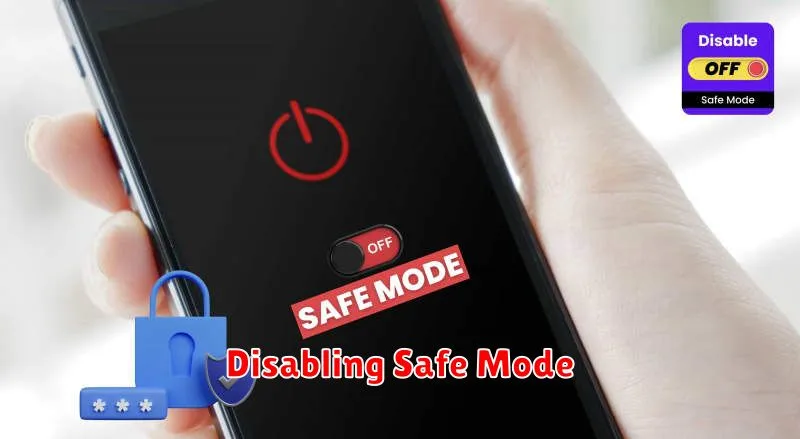Experiencing persistent issues with your Android device? Safe mode can be a powerful troubleshooting tool to help identify the root cause. Whether you’re facing app crashes, battery drain, or general performance problems, booting into safe mode allows you to run your Android system with only the pre-installed applications, temporarily disabling any third-party apps you’ve downloaded. This isolation helps pinpoint whether a downloaded app is the source of your device’s troubles.
This comprehensive troubleshooting guide will walk you through the steps of entering and exiting safe mode on various Android devices. Learn how to use safe mode to diagnose and resolve common Android issues. Understand the benefits of using safe mode and how it can be an invaluable asset in maintaining the optimal performance of your Android device. We’ll explore how to identify problematic apps, offering solutions for uninstalling or updating them to restore your device to its proper functioning.
What is Safe Mode?
Safe Mode is a diagnostic mode on Android devices that starts the phone with only the essential system applications and services pre-installed by the manufacturer. It temporarily disables all third-party apps downloaded from the Google Play Store or other sources.
Think of it as a clean boot for your phone. By running in this stripped-down state, you can determine whether a downloaded app is causing problems like battery drain, performance issues, or unexpected crashes. Safe Mode helps isolate the source of software-related problems.
Why Use Safe Mode?
Safe mode is a diagnostic tool for your Android device. It temporarily disables all third-party apps you’ve downloaded, leaving only the pre-installed system applications running. This helps you pinpoint whether a downloaded app is causing problems on your device.
If your phone is running slow, crashing, experiencing battery drain, or exhibiting other unusual behavior, safe mode can help you determine the culprit. By observing your phone’s performance in safe mode, you can isolate the issue.
Common issues safe mode can help diagnose include:
- Performance problems: Slowdowns, freezes, or frequent restarts.
- Battery drain: Unusually rapid battery depletion.
- Network connectivity issues: Trouble connecting to Wi-Fi or cellular data.
- App crashes: Apps frequently closing unexpectedly.
- Overheating: The device becoming excessively hot.
- Unexplained behavior: Unusual pop-ups, settings changes, or other unexpected actions.
If your device functions normally in safe mode, it strongly suggests a downloaded app is the source of the problem. This allows you to troubleshoot by uninstalling recently installed apps one by one until the issue is resolved.
How to Enable Safe Mode on Most Android Devices
For most Android devices, entering Safe Mode follows a similar process. This typically involves a combination of button presses while the device is powering on or restarting.
Step 1: Begin by pressing and holding the Power button as if you were turning off your device.
Step 2: A menu will appear with options such as Power off, Restart, and others. Long-press the “Power off” option.
Step 3: A prompt will appear asking if you want to reboot into Safe Mode. Tap “OK” or the equivalent confirmation option.
Step 4: Your device will restart and enter Safe Mode. You should see a “Safe Mode” indicator at the bottom of the screen. If you don’t see the indicator, repeat the steps.
How to Enable Safe Mode on Samsung Devices
Samsung devices have a slightly different method for entering Safe Mode, often involving hardware button combinations during startup or restart.
Method 1: Powering On
1. First, completely power off your Samsung device.
2. Then, press and hold the Power button to begin turning the device on.
3. As soon as you see the Samsung logo appear on the screen, immediately release the Power button and press and hold the Volume Down button.
4. Keep holding the Volume Down button until the phone finishes booting up.
5. You should see “Safe mode” displayed in the bottom-left corner of the screen if you’ve successfully entered Safe Mode.
Method 2: Restarting
1. If your phone is already on, press and hold the Power button to bring up the Power menu.
2. Tap and hold the “Power off” option.
3. A prompt to reboot to Safe mode will appear. Tap “Safe mode”.
How to Enable Safe Mode on Other Android Devices

While most Android devices follow a similar procedure for enabling Safe Mode, some manufacturers may have slightly different methods. If the previously described methods don’t work for your device, consult your device’s user manual or contact the manufacturer’s support directly. They can provide the specific steps for your particular model.
Additionally, some less common Android devices might have a dedicated hardware button combination for entering Safe Mode. This information is usually found in the device’s documentation. Carefully research the specific instructions for your device to avoid any unintended actions.
Here are some general tips for troubleshooting if you’re having trouble enabling Safe Mode:
- Check for software updates: An outdated operating system can sometimes interfere with Safe Mode activation. Ensure your device’s software is up-to-date.
- Restart your device: A simple restart can sometimes resolve temporary software glitches that might be preventing Safe Mode from starting.
- Search online forums: User forums and online communities dedicated to your specific device brand can often provide helpful advice and solutions.
Navigating in Safe Mode
Once your device is in safe mode, you’ll notice a “Safe mode” indicator typically displayed in the bottom-left corner of the screen. The visual appearance might vary slightly depending on your Android version and device manufacturer. While in safe mode, most pre-installed apps will function normally. However, third-party apps you’ve downloaded will be disabled.
Navigating your device in safe mode is similar to normal operation. You can still access your home screen, app drawer, and settings menu. The key difference is the absence of third-party apps. This limited environment is precisely what allows you to isolate and identify potential problems caused by downloaded applications.
Try performing the actions that were causing issues before entering safe mode. For example, if you were experiencing frequent crashes, try using the apps or features that previously triggered those crashes. If the problem doesn’t reoccur in safe mode, it suggests a third-party app is the likely culprit.
Troubleshooting Apps in Safe Mode
Once your device is in safe mode, begin troubleshooting to identify if a downloaded app is the source of your device’s issues. Observe your device’s performance and functionality. If the problem that was present in normal mode is gone in safe mode, it’s highly probable that a third-party app is the culprit.
To pinpoint the problematic app, start by thinking about recently installed apps before the issue began. Uninstall suspected apps one by one, rebooting into normal mode after each uninstallation to test if the problem is resolved. This process of elimination will help identify the specific app causing the disruption.
Important Note: While in safe mode, all third-party apps are temporarily disabled. This means you won’t be able to access or use them until you exit safe mode. This limited functionality focuses the troubleshooting process on identifying conflicts or issues stemming from downloaded applications.
Disabling Safe Mode

Turning off Safe Mode on your Android device is generally a straightforward process. The most common method involves simply restarting your phone. Power off the device completely, then power it back on normally. In most cases, this will deactivate Safe Mode.
If a simple restart doesn’t work, try a forced restart. This involves holding down the power button for a longer period, usually around 30 seconds. The device should power cycle and reboot, often clearing the Safe Mode trigger. Refer to your device’s user manual for the specific button combination if needed, as it can vary slightly between manufacturers.
Sometimes, a persistent notification related to Safe Mode will appear. If present, you might be able to disable Safe Mode directly through this notification by selecting the option to exit.
Advanced Troubleshooting with Safe Mode
Safe mode can be a powerful tool for identifying elusive issues on your Android device. Beyond simply pinpointing problematic apps, safe mode can also assist in diagnosing issues related to the operating system itself or customized launchers.
If a problem persists even in safe mode, it suggests the issue isn’t caused by third-party apps. This narrows down the potential culprits, pointing towards either a core system component or a configuration problem. For instance, unusual battery drain in safe mode might indicate a system process is malfunctioning.
Testing custom launchers or themes is another advanced use of safe mode. If you experience problems after applying customizations, booting into safe mode will revert to the default launcher. If the problem disappears, the customization is likely the root cause.
Keep in mind that while safe mode provides valuable insights, it doesn’t offer direct solutions. It primarily serves as a diagnostic tool, helping you isolate the cause of a problem and guide you towards an effective resolution. You may need to consult official documentation or support forums for further assistance once the problematic area has been identified.

